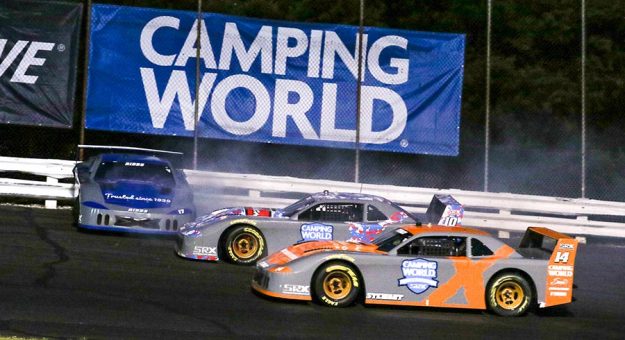The Superstar Racing Experience delivered on each word in its name.
The brainchild of NASCAR Hall of Fame inductee Ray Evernham and three-time NASCAR Cup Series champion Tony Stewart, the Camping World SRX Series debuted in June with stars such as Stewart and four-time Indianapolis 500 winner Helio Castroneves among its ranks.
A six-race, Saturday-night short-track format combined aspects of NASCAR, dirt racing and the International Race of Champions into one conglomerate of excitement, where tempers flared on-track and fan-driver interactions were more of a rule than an exception.
Twelve-car fields competed in six races on paved and dirt ovals throughout June and July, with each race broadcast to a nationwide audience on CBS.
Evernham channeled his creative instinct and decades of proficiency in innovation to design cars that attracted ringers, including defending NASCAR Cup Series champion Chase Elliott, rising star Hailie Deegan, former Formula 1 driver Scott Speed and dirt late model luminary Scott Bloomquist.
In the span of one pandemic-affected year, Evernham built a series that blossomed into must-see television for fans and a can’t-miss opportunity for drivers with backgrounds in sprint cars, sports cars, NASCAR, IndyCar, Formula 1, rallycross and dirt and asphalt late models.

The series made its first stops at Stafford (Conn.) Motor Speedway, Knoxville (Iowa) Raceway and Stewart’s own Eldora Speedway in Ohio. Events at Indiana’s Lucas Oil Raceway, Slinger (Wis.) Speedway and Nashville (Tenn.) Fairgrounds Speedway punctuated the slate.
Stewart won the inaugural Camping World SRX Series title over Trans-Am Series standout Ernie Francis Jr., NASCAR legend Bobby Labonte and NTT IndyCar Series veteran Marco Andretti.
Once the dust settled on season one, Evernham sat down with SPEED SPORT to recap SRX’s maiden voyage and the many wrinkles that may be in store for season two.
Q: What were some of the toughest challenges you faced in the first season of the Camping World SRX Series?
EVERNHAM: Honestly, getting parts and pieces on time. We had a great crew of people and I was lucky to be able to put them together, but the hardest thing they had to do was build 16 race cars in the middle of (the) COVID (pandemic), and we had to move tons of people on the road with all of the logistics. We did all of that in a condensed period of time.
Q: What were some of your favorite aspects of the season?
EVERNHAM: The camaraderie on the road with the team reminded me of the teams I worked with early in my career, like the IROC team and the No. 24 (Hendrick Motorsports NASCAR) team. The fans supported us. They loved us. There were packed houses everywhere we went. And, you know, the fact that we were doing something that people enjoyed, right? We’re doing motorsports entertainment. We accomplished that. And, I think the drivers had fun. I watched the drivers and the things that they did, and again, that camaraderie as a group was really, again, it was great. It was a lot of work, but it was fun. We had fun.
Q: What was some of the best feedback you received from competitors?
EVERNHAM: The fact that the cars were equal, and the cars were neatly prepared, and we did a good job going from place to place. The cars weren’t perfect anywhere, but they were drivable everywhere. And, you know, the fact that we were able to turn those things around weekly from dirt, to pavement, crashes, whatever. The drivers were very complimentary of what we put together and I think they enjoyed being able to give back to short-track racing. They were going to short tracks around America and interacting with fans, just like the old days. Some of them would stay and sign autographs for hours after an event. I think many of them enjoy getting back to their roots.
Click below to continue reading.
